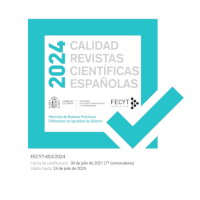The idealization of pain
Leopoldo Alas and Arthur Schopenhauer. Two clarinian stances
DOI:
https://doi.org/10.18172/cif.5494Keywords:
Leopoldo Alas, Schopenhauer, pain, aesthetics, metaphysicsAbstract
This paper aims at analyzing the convergences, divergences and influence of Arthur Schopenhauer on Leopoldo Alas “Clarín” in two phases of the latter’s literary and intellectual career. Critics of Alas have focused on this subject; however, this study intends to take it further by means of examining the function of human suffering in Alas’ aesthetic beliefs. In order to shed light on the basic principle behind this theme, Alas’ journalistic work has been analyzed, specifically the articles dealing with philosophical matters. This hermeneutical implement helps to set the fundamental premises of Alas’ philosophical thought and to ascertain his initial alignment. Also, this article contends that Schopenhauer played a major role in Alas' Spiritualism of the 1890s. The philosopher’s theory of pain is a key component of Alas’ aesthetics. This article strives to determine the artistic foundation of this major theme in the author's work, which has a metaphysical purpose.
Downloads
References
ALAS, L. (2003-2009). Obras Completas (12 vols.). ed. J. Oleza et al. Oviedo, Ediciones Nobel.
BESER, S. (1968). Leopoldo Alas, crítico literario. Madrid, Gredos.
CARLYLE, T. (1893). Los héroes: el culto de los héroes y lo heroico en la historia. trad. J. G. Orbón, introducción L. Alas. Madrid, Fernández y Lasanta.
CARLYLE, T. (1966). Heroes, Hero-Worship and the Heroic in History. ed. C. Niemeyer. Lincoln, University of Nebraska Press.
DIÓGENES LAERCIO (2007). Vida y opiniones de los filósofos ilustres. ed. C. García Gual. Madrid, Alianza.
FOX, J. (1907). “Divine Attributes”, The Catholic Encyclopedia. New York, Robert Appleton Company. http://www.newadvent.org/cathen/02062e.htm
GONZÁLEZ HERRÁN, J. M. (1987). “Construcción y sentido de Cuervo”. En Hitos y mitos de La Regenta. Oviedo, Caja de Ahorros de Asturias, pp. 86-92.
GUTHRIE, W. K. C. (2000). Los filósofos griegos. trad. F. Torner, 2a ed. México, FCE.
GUYER, P. y R. HORSTMANN (2021). “Idealism”, The Stanford Encyclopedia of Philosophy, ed. E. N. Zalta, (Spring 2021 Edition): https://plato.stanford.edu/archives/spr2021/entries/idealism/
LOZANO MARCO, M. A. (1987). “El relato ‘Las dos cajas’ en la obra narrativa de ‘Clarín’”. En Clarín y La Regenta en su tiempo: Actas del Simposio Internacional. Oviedo, Universidad de Oviedo, Ayuntamiento de Oviedo, pp. 859-872.
LISSORGUES, Y. (1998). “La crisis de fin de siglo. El regeneracionismo”. En V. García de la Concha (dir.), Historia de la literatura española. Siglo XIX (II). Madrid, Espasa, pp. 46-58.
MARESCA, M. (1985). Hipótesis sobre Clarín: el pensamiento crítico del reformismo español. Granada, Diputación Provincial.
OLEZA, J. (1976). “Clarín: las contradicciones de un realismo límite”. Alicante, Biblioteca Virtual Miguel de Cervantes: https://www.cervantesvirtual.com/nd/ark:/59851/bmcrr1v6
OLEZA, J. (1989). “Espiritualismo y fin de siglo: convergencia y divergencia de respuestas”. En F. Lafarga (ed.), Imágenes de Francia en las letras hispánicas. Barcelona, Promociones y Publicaciones Universitarias, pp. 77-82.
ORDEN JIMÉNEZ, R. (1998). El sistema de la filosofía de Krause. Génesis y desarrollo del Panenteísmo. Madrid, Universidad Pontificia Comillas.
PARMÉNIDES (2007). En Filósofos presocráticos. Obras, I. ed. C. Eggers et al. Madrid, Gredos.
PASSMORE, J. (1981). 100 años de filosofía. trad. P. Carrillo. Madrid, Alianza.
RENAN, E. (1968). Vida de Jesús. trad. A. G. Tirado. Madrid, Edaf.
RIBOT, T. (1874). La philosophie de Schopenhauer. Paris, Librairie Germer Baillière. https://gallica.bnf.fr/ark:/12148/bpt6k62468d/f4.item
RICHMOND, C. (2003). “Los relatos de Clarín: una autobiografía ficticia”. Alicante, Biblioteca Virtual Cervantes: https://cvc.cervantes.es/actcult/clarin/catalogo/ articulos/richmond01.htm
SAFRANSKI, R. (2009). Schopenhauer y los años salvajes de la filosofía. trad. J. Planells. Barcelona, Tusquets.
SCHOPENHAUER, A. (1961). Eudemonología. trad. J. B. Bergua. Madrid, Ediciones Ibéricas.
SCHOPENHAUER, A. (2010). El mundo como voluntad y representación. Trad. y ed. R. R. Aramayo. Madrid, Alianza.
SCHOPENHAUER, A. (2014). Parerga and Paralimpomena. Short Philosophical Essays. Ed. y trans. S. Roehr y C. Janaway. Cambridge, Cambridge University Press. DOI: https://doi.org/10.1017/9781139029636
SOBEJANO, G. (2002). “Alas sentimental”. En Vilanova, A. y Sotelo Vázquez, A. (eds.), Leopoldo Alas “Clarín”, Actas del Simposio Internacional (Barcelona, abril 2001). Barcelona, Universitat de Barcelona, pp. 311-323.
SOTELO VÁZQUEZ, A. (1996). “Schopenhauer, Zola y Clarín”. Anales de Literatura Española, 12, 13-26. https://doi.org/10.14198/ALEUA.1996.12.01 DOI: https://doi.org/10.14198/ALEUA.1996.12.01
SOTELO VÁZQUEZ, A. (2005). “Leopoldo Alas y ‘Doña Berta’”. En Díaz Larios, L. F. et al. (eds.), Lectora, Heroína, Autora (La mujer en la literatura española del siglo XIX). Barcelona, Universitat de Barcelona, pp. 347-355.
TOMÁS DE AQUINO (2001). Suma de Teología, Parte I. Madrid, Biblioteca de Autores Cristianos. https://www.dominicos.org/media/uploads/recursos/libros/suma/1.pdf
Downloads
Published
How to Cite
Issue
Section
License
Copyright (c) 2022 Fernando Villarreal Barajas

This work is licensed under a Creative Commons Attribution 4.0 International License.
The authors retain copyright of articles and authorize CIF the first publication. They are free to share and redistribute the article without obtaining permission from the publisher as long as they give appropriate credit to the editor and the journal.
Self-archiving is allowed too. In fact, it is recommendable to deposit a PDF version of the paper in academic and/or institutional repositories.
It is recommended to include the DOI number.
This journal is licensed under a Creative Commons Attribution 4.0 International License














